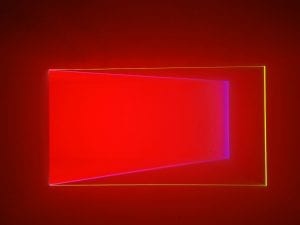Renowned American sculptor Larry Bell (b. 1939) offers a straightforward description of his practice: “My work is about the various properties of light and the way it interacts with surfaces.” Many of us have witnessed this interaction before, from the dazzling beam reflected off a car on a summer’s day to the eerily beautiful, rainbow luminescence of an oil spill. Through years of experimentation, Bell has explored this concept to the utmost degree. Phoenix Art Museum, Arizona, takes us on a journey through Bell’s impressive career in a new sprawling survey dedicated to the artist’s process from the 1960s to the present day. The show is called Larry Bell: Improvisations, and it is an expansive exhibition that features a wide range of glass cubes, sculptures, large-scale standing walls and mixed-media collages.
Bell was a prominent figure of the Light and Space Movement during the 1960s and 1970s. The loosely affiliated group of creative practitioners included the likes of Robert Irwin, Helen Pashgian, James Turrell and Mary Corse. Despite having widely different approaches, disciplines and media, they were all connected by a common desire to experiment with their viewers’ “perception and participation” through art. Surrounded by such inspiring figures, Bell began his career by creating cubic volumes out of shaped canvases and incorporating mirror, wood and glass elements into them. Early on, he discovered a vacuum deposition technique that allowed him to transfer thin film deposits onto glass panes. This gave his early cubes a dazzling sheen across an array of colours. From there, Bell used light as a medium to home in the different ways in which it would be reflected, absorbed, and transmitted through different surfaces.

Now, the most famous examples of his experimentation through the years will be on display. Visitors begin by surveying a selection of smaller scale glass cubes that appear either in their entirety or deconstructed. These are alongside smaller works that explore the right angle, underscoring Bell’s fascination with geometry. Untitled (2021) is a striking example of this. The piece is composed of three sheets of glass neatly folded into 90-degree angles and arranged inside each other. From above, the connecting lines guide our eyes to a single point, like arrows. Each layer is a different colour and the colours blend into each other when viewed from the side. Also on display are large-scale standing walls made up of 12 pieces of solid glass, showing how the artist scaled up his cubic investigations to installations and environments. He created each standing wall on-site, their shapes created in direct response to their settings. At 6 feet tall, they affect viewers’ perception, emphasizing the relationship between perceived versus physical realities.

This retrospective takes us from lesser known projects all the way until the present day. Improvisations features rarely exhibited collage works from the Phoenix Art Museum Collection, including examples from Bell’s Vapor Drawings (1978-present), Mirage (1980s-present) and Fraction series (1996-2001). These works on paper mirror the reflective, ambiguous and spatial qualities of Bell’s works that take up 3-Dimensional space. They were created by sending mylar, paper and other materials through the vacuum deposition technique and mounting press. This retrospective also debuts a selection of Bell’s recent Light Knot sculptures. Suspended from the ceiling, these appear to dance as they absorb and reflect the surrounding light. They are alongside a newly commissioned large-scale cube, which represents the mercurial sun and is surrounded by clouded glass evocative of the fog of Venice Beach, California.
There’s something mesmerising about seeing the way light interacts with different surfaces. Our eyes become attuned to the subtle gradients and unexpected hues. By moving around Bell’s sculptures, we gain fresh perspective, unlocking different colours and shapes. Today, we are seeing more contemporary artists explore our perceptions to great effect, such as photographers Jessica Backhaus and Sebastiaan Knot. Bell’s work includes an additional dimension that makes experiencing his endlessly engaging.
Phoenix Art Museum, Larry Bell: Improvisations | Until 5 January
Image Credits:
- Larry Bell, Untitled (2 x 3), 2021. Laminated glass coated with Inconel, SIO and Quartz, 16 x 19 x 19 in. Larry Bell Studio, Courtesy of the artist and Anthony Meier, Mill Valley.
- Larry Bell, Triolith (Poppy/Hibiscus) A, 2020. Laminated glass coated with Iconel, 12 x 24 x 12 in. Larry Bell Studio, Courtesy of the artist and Anthony Meier, Mill Valley.
- Larry Bell, Untitled (2 x 3), 2021. Laminated glass coated with Inconel, SIO and Quartz, 16 x 19 x 19 in. Larry Bell Studio, Courtesy of the artist and Anthony Meier, Mill Valley.
- Larry Bell, Triolith (Poppy/Hibiscus) A, 2020. Laminated glass coated with Iconel, 12 x 24 x 12 in. Larry Bell Studio, Courtesy of the artist and Anthony Meier, Mill Valley.





